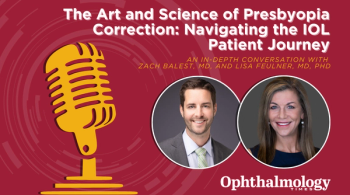
Stem cell treatment: What could possibly go wrong with procedure?
Surgeon offers some cautionary tales about unfortunate cases he has encountered
Stem cell therapies for ocular diseases often are of unproven efficacy and may result in vision loss, notes one surgeon.
Reviewed by Thomas A. Albini, MD
According to
The drops cost $5,000 per bottle and when questioned, the company told Dr. Albini that the more months of therapy the patient had the better and no data supports the treatment. Dr. Albini, professor clinical ophthalmology,
RELATED:
Patient saw a ‘specialist’
The first patient, a 78-year-old woman had undergone
Two days after the stem cell injection, she presented with minimal inflammation,
She had a history of dry AMD with VAs of 20/60 and 20/30 in the right and left eyes, respectively. Bilateral stem cell injections were administered resulting in bilateral crystalline lens subluxation, vitreous hemorrhage, and an acute intraocular pressure spike to 60 mm Hg. Emergency bilateral vitrectomies were performed for endophthalmitis, during which a retinal detachment was found in one eye.
The VAs at 12 months were no light perception bilaterally. Both cases were reported to the Therapeutic Surveillance Committee of the American Society of Refractive Surgeons, which knew of a third patient treated at the same clinic. That patient had dry AMD and following treatment after 12 months the VAs were hand motions and light perception in the right and left eyes, respectively, as a result of traction rhegmatogenous detachments and proliferative vitreoretinopathy.
Her previous VAs had been 20/40 and 20/200. Potential causes of the issues in these cases, noted Dr. Albini, were stem cell contamination, use of trypsin or collagenase during stem cell isolation, and effects of growth factors,
RELATED:
Stem cell regulation
These biologics are regulated by the
And herein lies the rub from the standpoint of how companies interpret the regulation. Low risk means that an
When those conditions are not met, the procedure is considered high risk and requires
“The VAs were poor in these patients,” Dr. Albini explained. “Intravitreal injection was the most common method of delivering the stem cells. There was an association in the patients between the injections and development of epiretinal membranes and traction retinal detachments in eight patients.”
The FDA decided to prosecute clinics providing these unproven stem cell treatments but are giving them three years to make changes before they face prosecution. There is a moratorium on further stem cell injections into the eye, Dr. Albini noted.
Red flags
Practitioners who are not eye specialists should not be treating eye disease, or charging patients for participating in research, i.e., patient-funded research. Patients have paid from $5,000 to $40,000 to participate in a
“Patients are desperate for alternative therapies for chronic diseases. Intravitreal cellular therapies can potentially cause posterior vitreous detachments and retinal detachments,” Dr. Albini concluded.
“This shows the importance of the regulatory environment that we live in. If we did not have these hurdles to go over to identify successful therapies, it would be hard to know which of these therapies really work and which do not and the line between hope and hoax would be blurred. The FDA does protect patients.”
RELATED:
Disclosures:
Thomas A. Albini, MD
E: [email protected]
This article was adapted from a presentation by Dr. Albini at the 2018 American Association of Ophthalmology meeting. Dr. Albini has no fi nancial interest in any aspect of this report.
Newsletter
Don’t miss out—get Ophthalmology Times updates on the latest clinical advancements and expert interviews, straight to your inbox.













































.png)


